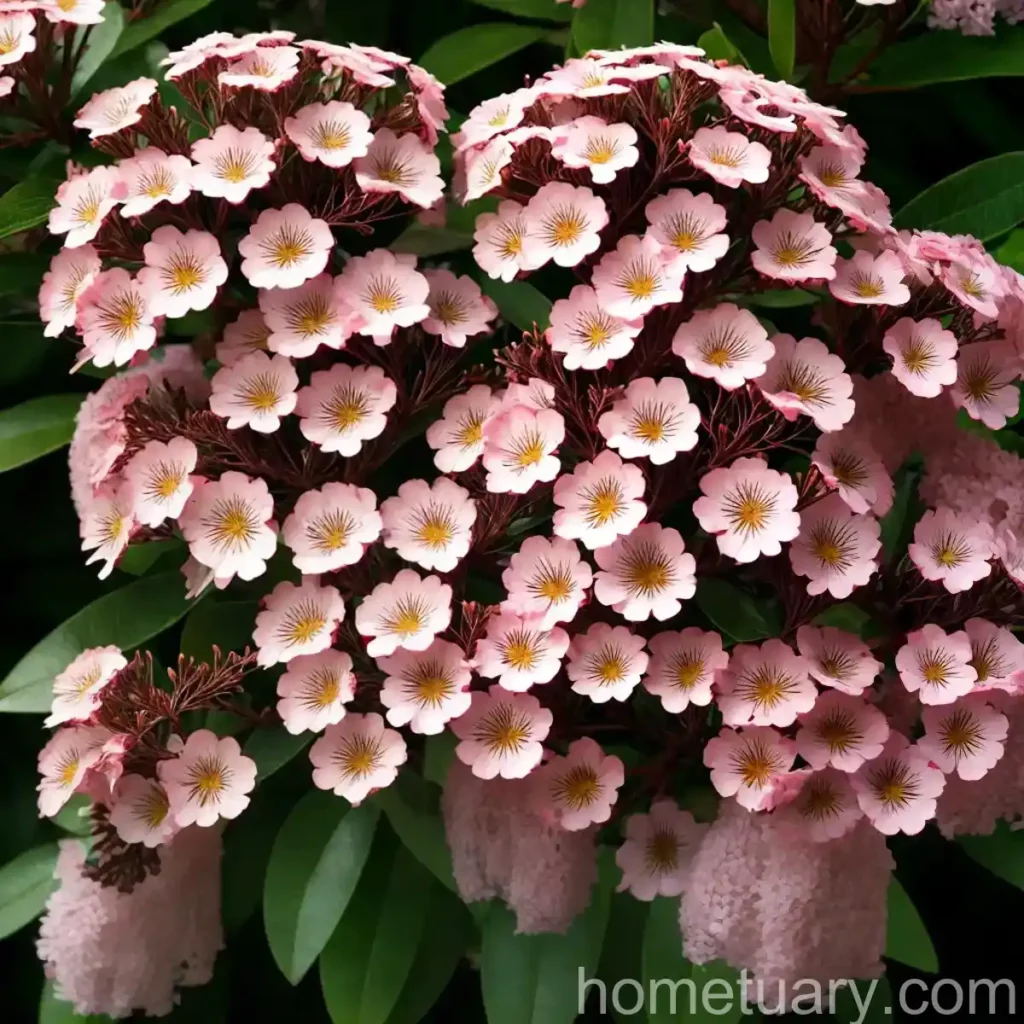Mountain Laurel (Kalmia latifolia ‘Bullseye’): A Complete Guide to Cultivation, Propagation, and Maintenance
In the world of gardening and landscaping, the mountain laurel (Kalmia latifolia ‘Bullseye’) stands out as a particularly stunning and versatile plant. Its vibrant and delicate flowers, along with its evergreen foliage, make it a desirable addition to any garden. This guide intends to delve deep into the various aspects of this beautiful plant, from its culture and uses to its maintenance and diseases.
What is Mountain Laurel (Kalmia latifolia ‘Bullseye’)?
The mountain laurel, scientifically known as Kalmia latifolia ‘Bullseye,’ is a species of flowering plant in the heather family, Ericaceae. It is native to the eastern United States, where it is found in the Appalachian Mountains and nearby regions. The ‘Bullseye’ variety is known for its striking pink and white flowers with distinct patterns, making it a popular choice among gardeners and landscaping enthusiasts.
Key Takeaways – Mountain Laurel (Kalmia latifolia ‘Bullseye’)
Before delving into the specifics of the culture, uses, and maintenance of mountain laurel, it’s essential to understand the key takeaways of cultivating and caring for this plant. The following points summarize the crucial aspects of growing and maintaining mountain laurel (Kalmia latifolia ‘Bullseye’):
- Culture: Understanding the plant’s cultural needs, including water, sunlight, soil, and fertilizer requirements, is crucial for its successful growth and development.
- Uses: Exploring the various uses of mountain laurel in landscaping and gardens, including its ornamental value and potential in containers.
- Maintenance: Learning about pruning, propagation, and common pest and disease management is essential for keeping mountain laurel healthy and thriving.
Now, let’s dive deeper into each of these aspects to better understand how to care for and appreciate the beauty of the mountain laurel (Kalmia latifolia ‘Bullseye’).
Culture
Water
Mountain laurel plants generally prefer moist, well-drained soil. As such, regular watering is crucial, especially during the plant’s establishment period. It’s important to ensure that the soil remains evenly moist but not waterlogged. During periods of dry weather, supplemental watering may be necessary to support healthy growth and flowering.
Sunlight
Mountain laurel (Kalmia latifolia ‘Bullseye’) thrives in partially shaded to fully shaded locations. While it can tolerate some sun, it generally prefers dappled sunlight or light shade, particularly in hot climate regions. Providing adequate shade can help prevent stress on the plant and maintain its vibrant foliage and blooms.
Fertilizer
When it comes to fertilizing mountain laurel, it is essential to use a slow-release, acid-loving fertilizer. Applying a balanced, acidic fertilizer formulated for rhododendrons, azaleas, and camellias in spring can support the plant’s healthy growth and flowering. However, it’s important not to over-fertilize, as excessive nutrients can harm the plant.
Soil
Mountain laurel (Kalmia latifolia ‘Bullseye’) thrives in well-drained, acidic soil with a pH level ranging from 4.5 to 6.0. The soil should be rich in organic matter and have good moisture retention capabilities. Amending the soil with organic matter, such as peat moss or compost, can help create an ideal growing environment for mountain laurel.
Uses
Ornamental Value
One of the primary uses of the mountain laurel (Kalmia latifolia ‘Bullseye’) is its ornamental value. Its showy, intricate flowers and glossy, evergreen foliage make it a prized addition to gardens, woodland areas, and naturalized landscapes. The plant’s striking blooms and year-round greenery contribute to its popularity as an ornamental shrub.
Container Planting
Mountain laurel (Kalmia latifolia ‘Bullseye’) also performs well in containers, making it a versatile choice for patio gardens, decks, and balconies. Its compact growth habit, elegant flowers, and glossy leaves enhance the visual appeal of outdoor spaces. When planting in containers, it’s important to ensure proper drainage and use acidic potting mixes suitable for acid-loving plants.
Maintenance
Pruning
Pruning mountain laurel (Kalmia latifolia ‘Bullseye’) is essential for maintaining its shape, promoting air circulation, and encouraging vibrant blooms. The best time for pruning is right after the plant has finished flowering. Careful removal of spent flowers and light shaping of the plant can help it maintain a neat and compact form. Any necessary pruning to remove damaged or overgrown branches should be done with caution to preserve the plant’s natural beauty.
Propagation
Propagating mountain laurel (Kalmia latifolia ‘Bullseye’) can be achieved through various methods, including stem cuttings and layering. Stem cuttings, taken from semi-hardwood growth, can be rooted in a suitable growing medium and kept under controlled conditions to encourage new root development. Layering, which involves encouraging stems to produce roots while still attached to the parent plant, is another effective method for propagating mountain laurel.
Common Diseases
Mountain laurel (Kalmia latifolia ‘Bullseye’) is susceptible to certain diseases, including phytophthora root rot and leaf spot diseases. Phytophthora root rot is a fungal disease that can cause root damage and lead to wilting and decline of the plant. Leaf spot diseases, caused by various fungi, can result in unsightly blemishes on the leaves. Proper cultural practices, such as maintaining good air circulation and avoiding over-watering, can help prevent these diseases.
Common Pests
Pests such as lace bugs and spider mites can potentially affect mountain laurel (Kalmia latifolia ‘Bullseye’). Lace bugs are small, winged insects that feed on the undersides of leaves, causing stippling and discoloration. Spider mites, which are tiny arachnids, can also infest the foliage, leading to webbing and damage. Regular monitoring and appropriate pest management measures can help mitigate these pest issues.
Botanist’s Tips
Enhancing Flowering
To encourage prolific flowering in mountain laurel (Kalmia latifolia ‘Bullseye’), it’s essential to provide the plant with the right growing conditions, including sufficient moisture, proper sunlight, and well-drained acidic soil. Additionally, avoiding excessive fertilizer applications and maintaining optimal soil pH can contribute to abundant and vibrant blooms.
Supporting Wildlife
Mountain laurel (Kalmia latifolia ‘Bullseye’) can attract pollinators, such as bees and butterflies, with its nectar-rich blossoms. By incorporating this plant into garden landscapes, individuals can contribute to supporting local pollinator populations and promoting biodiversity. Additionally, the dense foliage of mountain laurel can provide shelter for small wildlife species.
Fun Facts
- The mountain laurel (Kalmia latifolia ‘Bullseye’) is the state flower of Connecticut and possesses cultural significance in the region.
- While the plant’s flowers are visually captivating, all parts of the mountain laurel, including the leaves and stems, contain toxins and should be handled with care.
- Mountain laurel belongs to the same family as blueberries and cranberries, known for their characteristic acidic soil requirements.
Now that we’ve covered the essential aspects of mountain laurel (Kalmia latifolia ‘Bullseye’), let’s explore some additional details and resources that can further enhance our understanding and appreciation of this remarkable plant.
Links to External Resources
Plant Resources
- American Rhododendron Society – Mountain Laurel: This resource provides in-depth information on mountain laurel, including its characteristics, cultivation, and landscape use.
- The Connecticut Agricultural Experiment Station – Mountain Laurel: Learn about the history, ecology, and cultivation of mountain laurel in Connecticut, where it holds the status of state flower.
- University of Connecticut Plant Database – Mountain Laurel: Explore a comprehensive database entry on mountain laurel, detailing its botanical features, growth habits, and environmental preferences.
Pruning and Maintenance
- Pruning and Trimming Shrubs: Discover essential tips and techniques for pruning and shaping shrubs, including mountain laurel, to maintain their health and appearance.
- Plant Propagation Techniques: This resource offers insights into various plant propagation methods, such as stem cuttings, that can be applied to propagate mountain laurel.
Pest and Disease Management
- Integrated Pest Management for Home Gardeners: Understand the principles of integrated pest management to effectively address pest issues in garden settings, including those that may affect mountain laurel.
- Understanding and Managing Plant Diseases: Gain knowledge about common plant diseases, their symptoms, and management strategies to protect mountain laurel from potential infections.
Wildlife Support
- Attracting Pollinators to the Garden: Learn about creating pollinator-friendly environments and the role of plants, including mountain laurel, in supporting pollinator habitats.
- Habitat Improvement for Wildlife: Explore habitat enhancement practices that can benefit wildlife populations, with an emphasis on landscaping and plant selection.
Conclusion
In conclusion, the mountain laurel (Kalmia latifolia ‘Bullseye’) is a captivating and versatile plant with a myriad of uses in gardens, landscapes, and natural habitats. By understanding its culture, maintenance, and potential uses, individuals can cultivate and appreciate this remarkable species while contributing to the enhancement of their local environment.
Through careful attention to its specific requirements, including water, sunlight, soil, and pest management, individuals can promote the health and vitality of mountain laurel in their garden spaces. Additionally, integrating the plant into landscapes and supporting its role in wildlife habitats underscores its broader ecological significance.
As we continue to explore the diverse and intricate world of plants, the mountain laurel stands out as a testament to the beauty and resilience of nature. Whether for its stunning blooms, evergreen foliage, or ecological contributions, this remarkable plant continues to inspire and enrich our natural surroundings.















